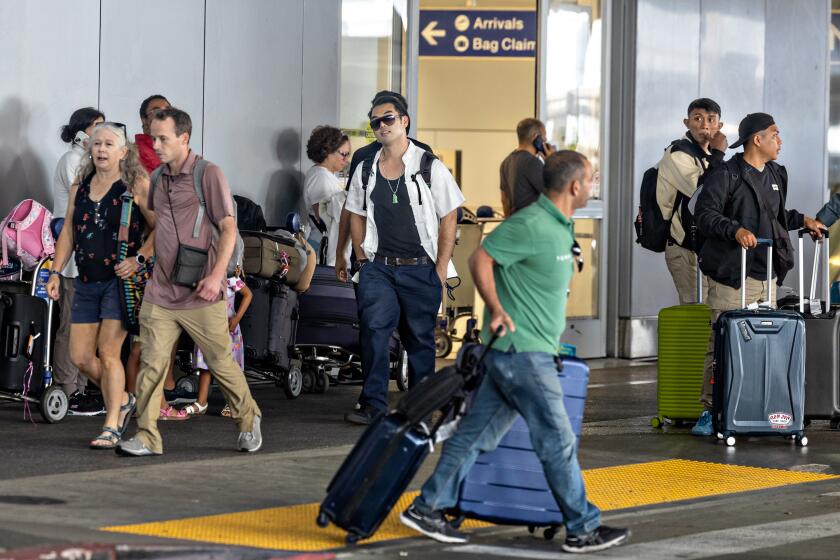California hits ‘very high’ COVID levels as virus in wastewater jumps significantly

- Share via
Coronavirus levels have jumped significantly in wastewater across the nation, an indication that the summer bump is continuing to grow.
National virus measurements in sewage reached “high” levels for the first time this summer, according to estimates released Friday by the U.S. Centers for Disease Control and Prevention. COVID-19 is growing or probably growing in 44 states and in the nation’s capital, the agency reported.
And for the first time since the winter, California has “very high” coronavirus levels in its wastewater, according to CDC data for the week ending July 6. California was one of seven states in this category; the others are Arkansas, Florida, Maryland, Nevada, Oregon and Texas. Nineteen other states, covering every region in the country, have high coronavirus levels in sewage.
Coronavirus levels in California’s wastewater are now estimated to be significantly higher than last summer. And in Northern California two of the largest sewersheds, covering San Jose and Palo Alto in Santa Clara County (the region’s most populous county), reported high levels of the virus in wastewater.
Also, the rate at which COVID tests are coming back with positive results in California has almost reached last summer’s peak. For the week that ended July 8, 13% of reported tests came back positive; the rate for the comparable week a month earlier was 4.8%. The latest positive test rate almost exceeds the peak from last summer, which was 13.1% in late August and early September.
COVID cases and hospitalizations rise in L.A. County — and some of those recently reinfected with the FLiRT variants are finding the latest bout the worst yet.
In Los Angeles County, the nation’s most populous, coronavirus levels in wastewater have jumped significantly.
In addition, “we are seeing an increase in the number of cases, emergency department visits and hospitalizations for COVID-19,” the L.A. County Department of Public Health said in a statement to The Times. “It is too early to tell whether or not there will be a larger wave this summer compared to last summer.”
For the 10-day period that ended June 29, the most recent information available, coronavirus levels in L.A. County sewage were at 27% of last winter’s peak, according to the health department. That’s up significantly from the prior comparable period, ending June 22, which was 17% of last winter’s peak.
COVID cases in the county also have jumped. For the week that ended July 7, there were an average of 307 new cases a day, up from 121 a day a month earlier. Last summer’s peak was a daily average of 571 cases for the week that ended Aug. 26.
Officially reported cases are certainly an undercount, given that they reflect only test results completed in medical facilities and not at-home tests. Plus, fewer people are testing for COVID when sick. But measuring case counts is still useful in evaluating overall trends.
It’s too early to know if FLiRT will be a major change in the COVID picture; so far impacts have been small. But officials are urging Californians to be prepared.
The percentage of coronavirus-related emergency room visits in L.A. County is also up. For the week ending July 7, 2.5% of ER visits were coronavirus-related; a month ago, it was 1.5%. Last summer’s peak was recorded for the week that ended Aug. 27, when 5.1% of emergency room visits were related to the coronavirus.
The midyear COVID case increase started in May, arriving earlier than normal. Previously, L.A. County’s midyear bump in cases and hospitalizations began in early July — in 2021 and 2023 — but in early May in 2022.
Across California, COVID in wastewater has entered the high level, the first time since February.
Kaiser Permanente Southern California is continuing to observe rising cases, mostly among outpatients, officials said.
“The numbers are kind of still slowly, slowly rising,” said Dr. Elizabeth Hudson, Kaiser Southern California’s regional chief of infectious disease. “We’ll have to see where things go now, because now we’re after the Fourth of July, and that’s usually when we start to see more of an increase if we are going to see it.”
Health officials from coast to coast are closely watching the increase in infections. New York City’s Department of Health and Mental Hygiene on Tuesday urged residents to consider wearing a mask, especially in crowded indoor settings and particularly for higher-risk people, given increasing cases there. “Mask up, NYC!” the agency said in a social media post, featuring an illustration of passengers on mass transit masking.
The increase in coronavirus infections comes as a new class of subvariants called FLiRT, which is estimated to be 20% more transmissible than the winter’s dominant subvariant, is ascendant. For the two-week period that ended July 6, an estimated 70.5% of COVID specimens nationwide were of the FLiRT subvariants — officially known as KP.3, KP.2 and KP.1.1. That’s up from 54.9% a month earlier.
The CDC identified no states in which the summer COVID wave is declining or probably declining. Three states had either a stable or uncertain trend in COVID cases — Hawaii, New Mexico and Oregon, according to the CDC. Estimates were not available for Missouri, Wisconsin or Wyoming.
More to Read
Sign up for Essential California
The most important California stories and recommendations in your inbox every morning.
You may occasionally receive promotional content from the Los Angeles Times.









![Vista, California-Apri 2, 2025-Hours after undergoing dental surgery a 9-year-old girl was found unresponsive in her home, officials are investigating what caused her death. On March 18, Silvanna Moreno was placed under anesthesia for a dental surgery at Dreamtime Dentistry, a dental facility that "strive[s] to be the premier office for sedation dentistry in Vitsa, CA. (Google Maps)](https://ca-times.brightspotcdn.com/dims4/default/07a58b2/2147483647/strip/true/crop/2016x1344+29+0/resize/840x560!/quality/75/?url=https%3A%2F%2Fcalifornia-times-brightspot.s3.amazonaws.com%2F78%2Ffd%2F9bbf9b62489fa209f9c67df2e472%2Fla-me-dreamtime-dentist-01.jpg)




